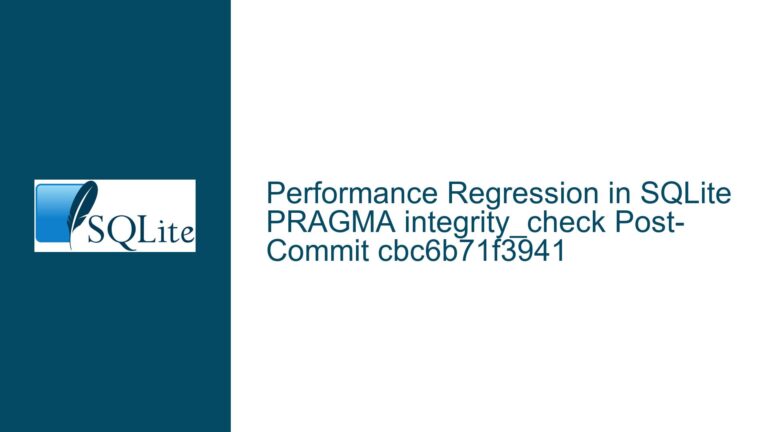SQLite SELECT Query Causes Full Disk: Investigating Temporary File Usage and Disk Space Consumption
Understanding SQLite’s Temporary File Behavior During SELECT Queries
When executing a SELECT query in SQLite, especially on a moderately large database (e.g., ~40 MB), unexpected disk space consumption can occur. This issue often manifests as high disk I/O and significant disk usage that doesn’t correlate with visible files in the filesystem. The root cause lies in SQLite’s handling of temporary files, which are used for operations like sorting, indexing, and storing intermediate results. These files are often created and immediately unlinked, meaning they don’t appear in directory listings but still consume disk space. This behavior can lead to confusion when monitoring disk usage, as tools like du and df may report inconsistent results.
SQLite’s temporary file management is influenced by several factors, including the database’s size, the complexity of the query, and the configuration of the temp_store and temp_store_directory settings. By default, SQLite may use disk-based temporary storage even when the database is located in a memory-backed filesystem like tmpfs. This can result in significant disk I/O and space consumption, particularly if the query involves large result sets or requires extensive sorting and indexing.
To diagnose and resolve this issue, it’s essential to understand how SQLite creates and manages temporary files, how these files interact with the filesystem, and how to configure SQLite to minimize disk usage. This guide will explore the underlying mechanisms, identify potential causes of excessive disk consumption, and provide actionable solutions to mitigate the problem.
Why SQLite’s Temporary Files Are Invisible and Consume Disk Space
SQLite’s temporary files are designed to be ephemeral, created and deleted as needed during query execution. However, the way these files are handled can lead to unexpected disk usage. When SQLite creates a temporary file, it typically unlinks the file immediately after creation. Unlinking removes the file’s directory entry, making it invisible to tools like ls or du. However, the file’s inode remains active as long as the SQLite process holds an open file descriptor to it. This means the file continues to consume disk space until the process closes the file or terminates.
The location of these temporary files is determined by SQLite’s configuration and the operating system’s temporary file directory settings. On Linux, SQLite may use directories like /var/tmp or /tmp for temporary storage. If /tmp is mounted as a tmpfs (a memory-backed filesystem), temporary files created there will consume memory instead of disk space. However, if SQLite uses a directory like /var/tmp, which is typically disk-backed, temporary files will consume physical disk space. This discrepancy can lead to situations where disk usage grows significantly, even though the database itself is stored in a memory-backed filesystem.
The issue is further complicated by the fact that SQLite’s temporary file usage depends on the query’s complexity. For example, a SELECT query that involves sorting a large result set or creating an automatic index may require substantial temporary storage. If the temp_store setting is configured to use disk-based storage (the default), SQLite will create temporary files on disk, leading to high disk I/O and space consumption. Understanding these mechanisms is crucial for diagnosing and resolving disk usage issues.
Diagnosing and Resolving SQLite’s Temporary File Disk Usage
To address SQLite’s temporary file disk usage, follow these steps:
1. Identify the Temporary File Location:
Determine where SQLite is creating temporary files by checking the temp_store_directory setting. This can be done using the PRAGMA temp_store_directory; command. If the directory is set to a disk-backed location like /var/tmp, consider changing it to a memory-backed location like /tmp (if mounted as tmpfs). Note that the temp_store_directory setting is deprecated in recent SQLite versions, so alternative approaches may be necessary.
2. Configure temp_store to Use Memory:
SQLite’s temp_store setting controls whether temporary files are stored in memory or on disk. By default, this setting is set to 0 (disk-based storage). To reduce disk usage, set temp_store to 2 (memory-based storage) using the PRAGMA temp_store=2; command. This will force SQLite to use memory for temporary storage, minimizing disk I/O and space consumption.
3. Monitor Disk Usage with Appropriate Tools:
Use tools like lsof to identify open temporary files that have been unlinked but still consume disk space. For example, run lsof | grep deleted to list all deleted files that are still held open by processes. This can help you confirm whether SQLite is the source of the disk usage. Additionally, compare the output of du and df to identify discrepancies caused by unlinked files.
4. Optimize Query Performance:
Reduce the need for temporary storage by optimizing your queries. For example, avoid sorting large result sets or creating automatic indexes unless necessary. Use EXPLAIN QUERY PLAN to analyze query execution and identify operations that may require temporary storage. Consider adding explicit indexes to reduce the need for automatic indexing.
5. Use a Memory-Backed Database for Temporary Data:
If your workload involves frequent temporary storage, consider using an in-memory database for temporary data. For example, create a separate SQLite database in memory using the :memory: filename and store temporary data there. This approach can significantly reduce disk I/O and space consumption.
6. Upgrade to the Latest SQLite Version:
Ensure you are using the latest version of SQLite, as newer versions may include optimizations and bug fixes related to temporary file management. Check the SQLite release notes for relevant updates.
By following these steps, you can diagnose and resolve SQLite’s temporary file disk usage issues, ensuring efficient query execution and optimal resource utilization.






